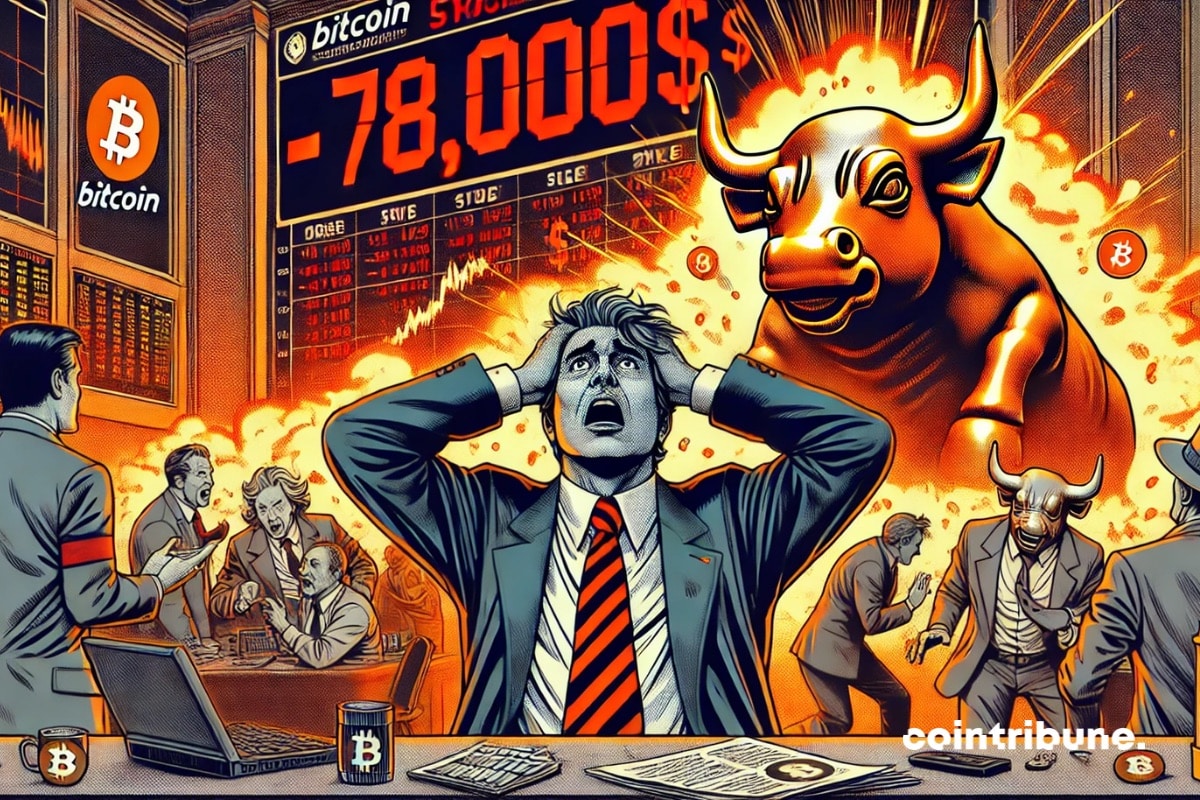As cryptocurrencies reshape the boundaries of finance, the United States takes a historic step. The Bitcoin Act of 2025, submitted to the House of Representatives, proposes to create a strategic reserve of one million BTC over two decades. A bold maneuver, blending financial innovation and geopolitical vision. Far from being a simple accumulation of digital assets, this project embodies a strategic realignment in the face of digital gold. Explanations.
Theme Bitcoin (BTC)
As Bitcoin hovers around $81,000, a massive transfer of nearly 12,000 BTC by the former defunct giant reignites speculation. Between the psychology of the players and invisible market mechanisms, a breakdown of a tremor that recalls the fragility of an ecosystem still marked by its ghosts. Did Mt. Gox just…
A bitcoin at $70K? Nothing to faint over! The market dances, retracts, but doesn't stumble. Those who wait will see the next act of the show.
Bitcoin has plunged to $76,700, marking its lowest level in four months amid global economic turmoil. Indeed, the 30% drop from its all-time high of $109,350 has reignited discussions about a possible trend reversal, as some observers question the sustainability of the bullish cycle. However, several indicators suggest that this correction could represent a strategic entry point for investors. On one hand, financial markets remain under pressure with persistent economic uncertainties, while on the other hand, the BTC derivatives market shows unexpected strength. So, has Bitcoin reached its ultimate floor before a rebound?
As the United States embraces bitcoin, Europe bogs down by continuing to promote the dystopia of the digital euro.
Financial and crypto markets continue to experience severe declines as investors await inflation data and the FED's decisions. Despite favorable regulatory advancements, Bitcoin and Ethereum are falling, in hope of a relief that will certainly come from the upcoming CPI and FOMC data. But what will it really be?
Peter Schiff, a well-known advocate for gold and a fierce critic of Bitcoin, did not miss the opportunity to mock crypto investors following the recent drop in prices. As Bitcoin lost nearly 30% of its value in just a few weeks, the economist threw out a provocative jab on social media.
Crypto: Banking giant BBVA gets the green light to offer Bitcoin and Ether. Find out the details in this article!
Time no longer has control over the crypto markets. Coinbase has just broken free from fixed hours by announcing 24/7 trading of futures contracts on Bitcoin and Ethereum for American residents. This is a revolution that, beyond simplifying access, redefines the rules of the game in the face of fierce competition. But behind this boldness lie subtle stakes: regulation, technical innovation, and a battle to dominate a rapidly growing derivatives market.
Strategy's CEO, Michael Saylor, is planning a massive fundraising to continue accumulating Bitcoin. Already holding nearly 500,000 BTC, the company is launching an ambitious "ATM Program" that could transform the market.
European lawmakers maintain an intriguing silence in the face of Donald Trump's executive order aimed at creating a strategic reserve of bitcoin in the United States. While this decision marks a major turning point in global monetary policy, the lack of response in Europe raises questions: mere indifference or a response in preparation?
The crypto market is wavering, Bitcoin is collapsing, and CZ reminds us that history repeats itself: roller coasters, a thrill ride, and traders already regretting not having sold.
Bitcoin (BTC) fell to $78,000 this Monday, losing 4% on the day, as stock markets plummet. According to recent crypto data, the BTC/USD pair hit $79,170 on Bitstamp, continuing a downward trend that began before the weekly close. What's next for Bitcoin?
The evolution of the Canadian political landscape could disrupt the crypto ecosystem. Mark Carney, former governor of the Bank of Canada and the Bank of England, has just been appointed to succeed Justin Trudeau. His rise to power does not go unnoticed, particularly in the crypto sector. Known for his sharp criticisms of bitcoin, Carney has previously described the asset as a deficient monetary model, which fueled a "global speculative mania." His vision, rooted in a centralized approach to finance, suggests a restrictive policy towards cryptos. As Canada continues to seek its regulatory guidelines for these assets, Carney's appointment could represent a radical shift. His influence on the future of bitcoin and cryptos in Canada deserves close scrutiny.
Bitcoin, often seen as a safe haven against the failures of traditional currencies, is experiencing a striking paradox. While the US dollar is eroding at an unprecedented rate over the last 12 years, the crypto king stumbles. How can this disconnect be explained? Behind this contradiction lie obscure financial mechanisms, neglected indicators, and a silent standoff with central banks. Jamie Coutts, a seasoned analyst at Real Vision, sheds light on this high-stakes duel.
Bitcoin begins a crucial week following a significant drop that has shaken the market. Amid macroeconomic uncertainties, tensions over interest rates, and technical indicators under pressure, investors are closely monitoring the upcoming movements. Despite a sentiment of extreme fear, some signals suggest a possible reversal. Here are 5 major elements to watch this week!
Amid revolutionary announcements, technological advancements, and regulatory turbulence, the crypto ecosystem continues to prove that it is both a realm of limitless innovations and a battlefield of regulatory and economic conflicts. Here is a summary of the most significant news from the past week surrounding Bitcoin, Ethereum, Binance, Solana, and Ripple.
Popular in words, forgotten in actions: bitcoin fascinates but does not convince. 4% of the earth's population believes in it, the others watch, perplexed, this digital gold without bars.
Investors are closely monitoring every signal from the American Federal Reserve (Fed), whose monetary policy could trigger a bear market. While some were hoping for rate cuts as early as 2024, the latest statement from Fed Chair Jerome Powell has dampened those expectations. The absence of rate reductions could put pressure on financial markets, particularly on risky assets like Bitcoin. Economist Timothy Peterson warns: if the Fed does not cut rates by 2025, the Nasdaq could collapse, dragging the cryptocurrency market along with it. A new correction of Bitcoin below $70,000 is now a serious possibility.
The financial story of the United States may well be on the brink of a major turning point. As the national debt reaches new heights and economic tensions escalate, a key player in the crypto sector, Michael Saylor, proposes a bold strategy: to make bitcoin a national strategic asset. At a summit held at the White House, the founder of Strategy advocated for massive investment by the U.S. government in bitcoin, suggesting that the United States should acquire up to 25% of the total supply by 2035. This proposal, as ambitious as it is controversial, relies on a long-term vision in which bitcoin would become a pillar of American economic prosperity. In response to this announcement, the White House has already taken a first step by signing a decree that establishes a strategic reserve of bitcoin.
At the recent crypto summit at the White House, Michael Saylor, co-founder of Strategy, presented an ambitious strategy aimed at generating up to 100 trillion dollars in economic value over the next decade. All of this, based solely on bitcoin! How?
Bitcoin (BTC) could soon experience significant volatility and trigger over $1.13 billion in long position liquidations if its price falls below the critical threshold of $82,000. Currently trading at $83,000, bearish pressure is intensifying as investors react negatively to recent announcements regarding the strategic bitcoin reserve in the United States.
The Salvadoran government has added more than 13 bitcoins to its reserves since March 1, openly defying the conditions of the $1.4 billion loan provided by the International Monetary Fund. Despite international pressures, President Nayib Bukele claims that nothing will stop his country's accumulation strategy.
Political decisions shape the future of cryptocurrencies, and the crypto summit organized by the Trump administration at the White House on March 7 is a glaring proof of this. This event, which aimed to establish a new posture for the United States towards the blockchain industry, sparked mixed reactions. While some observers see it as an institutional recognition of Bitcoin and a strategic turning point, others denounce it as a mere political stunt without concrete measures. This meeting, which coincided with the announcement of the creation of a strategic reserve of Bitcoin, had an immediate impact on the markets, leading to a 7.3% drop in BTC and massive outflows from Bitcoin ETFs. So, real progress or just a publicity stunt?
According to a recent study by crypto market researcher Mark Quant, the increase in the Global Liquidity Index (GLI) could be a key factor in the recovery of the cryptocurrency market. This dynamic could propel the total market capitalization beyond 4 trillion dollars by the second quarter of 2025, thereby reaching new historical highs.
The French justice system is currently facing a bitcoin fraud case of considerable magnitude, involving two Franco-Israelis accused of embezzling nearly 12 million euros. One of them, Julien-Daniel X., is being held in detention after being arrested in France during a ski trip. He claims to have been arrested solely because he is Israeli.
Donald Trump is hosting over 20 leaders of the crypto industry at the White House tonight for an unprecedented summit. This meeting, scheduled from 6:30 PM to 10:30 PM UTC, comes on the heels of the signing of a presidential decree establishing a Strategic Reserve of Bitcoin.
The NFT eldorado has turned into a frozen desert: 13.7 billion in volumes vanished, a crash worthy of the most beautiful digital illusions. Who will still bet on these mirages?
As cryptocurrencies divide global geopolitics, Russia is carving a unique path. Vladimir Putin, while acknowledging the intangibility of bitcoin, categorically refuses its integration into national reserves. This position contrasts with that of Donald Trump, a fervent advocate of a crypto-sovereign America. Between technological fascination and strategic caution, Moscow plays a subtle balance on the digital chessboard.
The flagship cryptocurrency experienced a significant decline following the official signing of the U.S. presidential decree establishing a strategic reserve of Bitcoin. While investors hoped for massive purchases by the government, the reality proved to be less ambitious, causing a market correction.





























